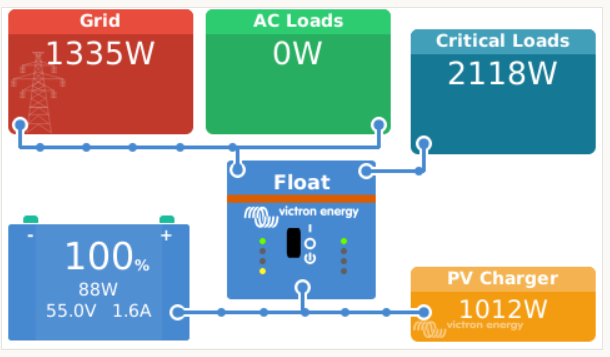My system is composed by:
- 4.5 kWp solar array
- 1x 150/85 VE.Can mppt
- 1x MultiplusII 48/5k (single-phase)
- 1x GX Venus
- 1x smartShunt
- 11kWh 48v lithium battery
- External BMS, not connected to the system.
- Modbus meter connected to the GX and measuring grid
ESS & Multiplus Configured for:
- Mode: Optimized w/o BatteryLife
- External meter on Ac-In, just after the grid connection.
- House loads on ac-out1, ac-out2 not connected to anything
- Sporadic car charger on Ac-In (between meter and multi) / Ac-In setup as in use.
- DVCC disabled.
- Charge and Inverter limits disabled.
- Feed-in disabled.
- Grid setpoint 20w
- Minimum SOC 30%
- Battery voltages: Absorption 55,3v / Float 55v / Low shutdown 44,8v
- Battery capacity 200Ah
- Lithium system with other BMS (not connected)
- Mppt & smartShunt configured with the same parameters.
In my zone it's normal for a period of the year to suffer grid blackouts. They can be from minutes to several hours, but I have no problem with quality.
When a blackout happens, the system behaves correctly.
When the grid returns, the multi charger starts itself, sometimes faster than others, but the loads on ac-out1 only receive energy from the grid. The mppt continues to serve energy from the panels, but only for the battery charge and all loads are supplied from the grid.
Also, it seems to be a problem with energy flow management as it's intermittently reporting big loads on ac-in, when I don't have anything connected to it.
The problem persists (waited hours) until the Multiplus is hardware-restarted by completely turning it off, waiting and then turning on again (switch at the bottom)
This is a big problem for me, as I mention there will be blackouts. I like the possibilities of ESS but If I can't solve this, I'll be forced to migrate it to virtual switch, and that's not optimal for the size of my system.
Also I noticed that while the blackout, the charging phase always show "Inverting" and the Victron nodes, mqtt, etc, all output alike. I would like to know where I can report this as an issue, like in some git project. Not reporting the battery charging phase does disallow making automations based on this data. It's valuable for diverters, for example, as the setpoint should be different on every stage.
With the pass of days I'm seeing that the changes/problems are more extense. I'm concerned about two of them:
Before, it charged the battery until absorption at full throttle. Now it charges at low power (@1500w max.) even when more solar yield is available, as it is applying some kind of manager that wants to extend the charge to the full day. That's not good because in my region the available sun is scarce, and I have to get the battery full as soon as possible.
Then there is a strange behaving after the absorption phase. I have Float 0,3v lower than absorption. Before when absorption ended it gently left the battery alone (power between 0 and 20w, and slowly with the normal use it reached float. Now it applies a constant -200w load that is steady for more than 1 hour. I don't know if that's a false measurement (possibly), but the effect is that no other diverting appliances can be used in float, as it always reports negative power to the battery, while loads are successfully supplied by solar.
Thanks!


